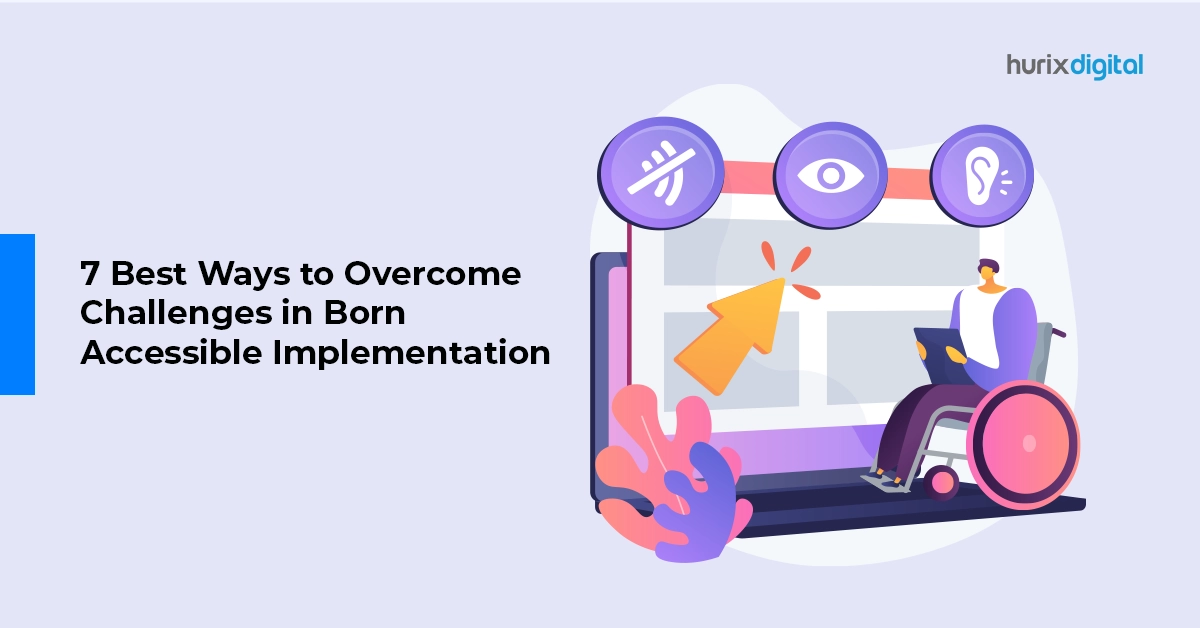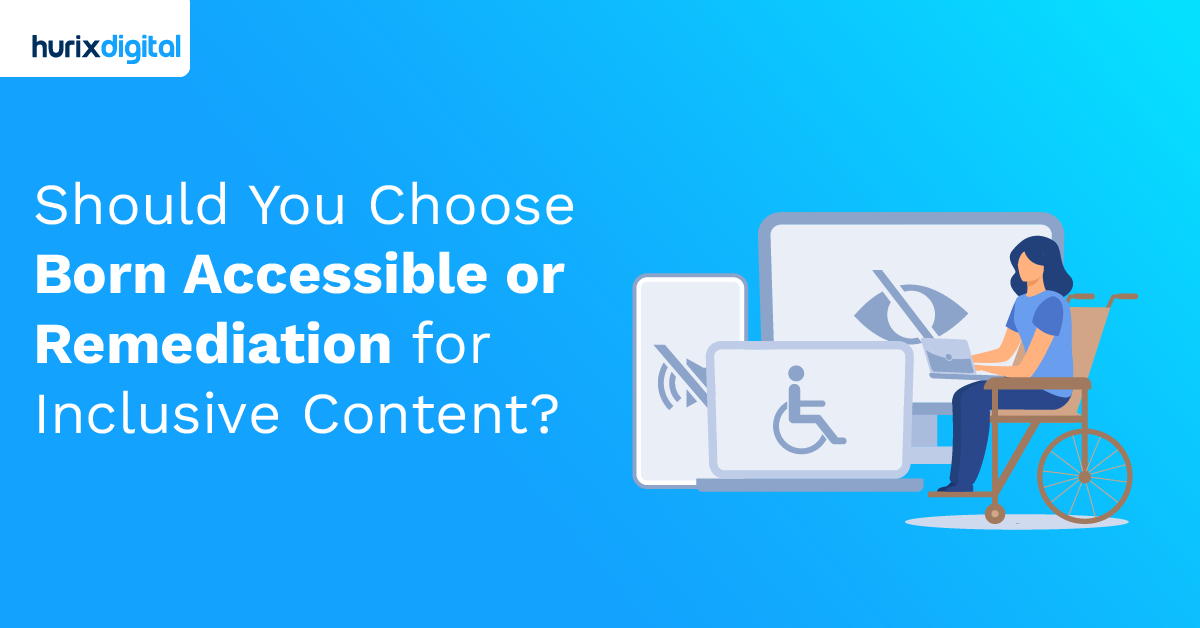
7 Best Ways to Overcome Challenges in Born Accessible Implementation
Walking through the library or bookstore, choosing a book, and reading might seem routine. But for some, like those with visual impairments, it’s not that simple. They need assistive technology for digital reading, and if books aren’t naturally accessible, it’s a problem. This is why ensuring that content is born accessible is essential.
The implementation of born-accessible content takes effort, precision, and a keen understanding of the challenges involved. It also requires a commitment to inclusivity and a recognition of the evolving digital landscape.
In this post, we will take you through the top 7 strategies to ensure a successful born-accessible implementation. These strategies are designed to address the complexities that arise in making digital content universally accessible, catering to diverse needs. Let’s start!
Table of Contents:
- What Does Born Accessible Content Refer to?
- Importance of Born Accessible Adoption in 2024
- Challenges in Born Accessibility Implementation
- 7 Effective Strategies to Overcome Challenges in Born Accessible Implementation
- To Conclude
What Does Born Accessible Content Refer to?
Born accessible is an umbrella term that refers to creating accessible books and content in general in such a way that they are inherently inclusive and usable by everyone, including individuals with disabilities.
The term “born accessible” emphasizes the idea that accessibility should be considered from the very beginning of the content creation process rather than being added as an afterthought or retroactively.
Also Read: WCAG Wonders: A Guide to Boosting Accessibility through Remediation Solutions
Importance of Born Accessible Adoption in 2024
From promoting inclusivity to tapping into new markets, accessibility implementation has endless benefits.
Let’s have a quick rundown on how having accessible strategies can help your business:
1. Reach Uncharted Territories
Around 1 in 8 people encounter difficulties reading or comprehending traditional prints. These include people with visual impairments and baby boomers. User-centered accessibility allows you to tap into unexplored markets and reach more users.
2. Make the Book More Noticeable
Born-accessible content makes your material more noticeable in the digital landscape. Search engines often prioritize accessible websites, enhancing your visibility and ensuring that your content reaches a broader audience.
3. Streamline Production
Born accessible adoption allows you to create a single accessible e-book and distribute it on different channels. This not only saves costs but also makes the publication process quick and streamlined.
4. Save the Expenditure on Retrofitting
Born accessible is a relatively new concept. Most legacy publications aren’t accessible, requiring the publishers to spend a subsequent amount on retrofitting. Accessibility implementation will not add to the retrofit expenditure.
Challenges in Born Accessibility Implementation
Implementing born-accessible strategies may seem simple on paper, but in reality, it can be different. Some obstacles can make adoption difficult.
Here, we have listed some of the common challenges businesses face:
1. Lack of Collective Awareness
One of the major challenges in born-accessible adoption is the lack of collective and comprehensive awareness.
Many publishers remain unfamiliar with the intricacies of born-accessible principles, lacking a comprehensive understanding of the best practices, guidelines, and standards associated with this approach. This limited awareness ultimately impedes the seamless creation and adoption of accessible e-books.
2. Technical Complication
Creating accessible books requires proper coding. In addition, the content needs to adapt to advanced assistive technology devices, so users can easily comprehend it. Also, the accessibility standards are updated periodically. Such technical complexities can make them difficult to implement born accessible.
3. Converting Printed Content to Digital
Publishers worldwide often contend with substantial backlogs of content, spanning both the print and digital realms, lacking adherence to accessibility standards. The endeavor to convert this legacy content into an accessible format is not only time-consuming but also demands a significant allocation of resources.
7 Effective Strategies to Overcome Challenges in Born Accessible Implementation
While you may encounter roadblocks in implementing born accessible across the organization, there are some practical ways to clear these obstacles.
Here are some basic yet effective ways to overcome the challenges:
1. Identify Barriers to User-Centric Accessibility
For implementing born-accessible practices, you need to identify various barriers.
For example, apart from print disabilities, people with visual impairments and cognitive disabilities have difficulties in perceiving or understanding printed text. It’s important to identify these disabilities to implement accessibility standards smoothly.
Let’s understand this with an example: Most academic books have color-coded graphs. This information can be inaccessible to people with low vision or color blindness. Born accessibility focuses on using alt text so the screen reader can scan and comprehend it.
2. Make Digital Content Adaptable to Different Devices
As assistive technology advances, new devices and platforms have come up. Each of these devices has unique characteristics and features. Implementing born-accessible adoption ensures the content is displayed and accessed properly across different devices.
For example, your book should be accessible via desktop, laptop, e-readers, and wearables. It will help you reach a huge user base, irrespective of future device trends.
3. Compatibility with Different Assistive Technologies
Assistive technologies have evolved over the years. There are advanced screen readers, alternative input devices, and screen magnifiers, ensuring users with disabilities can access and interact with the content more effectively.
Make sure the books are compatible with different kinds of assistive technologies. It is also a great way to future-proof the content, as it remains usable with evolving technology.
4. Adapting to Evolving Accessibility Guidelines
Accessibility standards are continuously upgraded to fit the changing technological landscape and user requirements. It’s important to adapt to the latest accessibility guidelines and requirements. Taking this proactive step will make your books future-proof and stay updated with changing accessibility standards.
5. Repurpose the Content
Structured and formatted the content to make repurposing easier and more streamlined. Such content will help you reuse it in various formats. You can repurpose the content for an audiobook or EPub. It will help you create content that is adaptable for future formats without making additional modifications.
6. Adoption of Future Technology
Futuristic technologies are becoming more mainstream. There are VR and AR devices, along with voice assistants.
Make sure your content is seamlessly integrated with emerging technologies. Integrating a kid’s storybook into a VR device can help children with learning disabilities, such as dyslexia, understand the content most effectively.
7. Ensuring Longevity and Budget-Friendliness
Implementing born-accessible content from the outset helps you cut down on the overhead and time-consuming process of retrofitting accessibility measures. Since accessible content has a longer lifecycle, you can maintain and update it to meet future needs. In the long term, accessibility is cost-efficient and reduces maintenance expenditures.
Also Read: Healthcare Access for All: Navigating USA’s Digital Accessibility Standards
To Conclude
Born accessible has become the need of the hour. It not only fulfills legal obligations but also helps your publishing business get more traction.
However, implementing born-accessible strategies can be complex. It requires a meticulous approach involving a blend of technological expertise, a commitment to inclusivity, and adherence to evolving accessibility standards.
If you are looking for experts who can help you with born-accessible adoption, Hurix Digital can help. With a proven track record in navigating the complexities of accessibility, we ensure that your content is not just compliant but genuinely accessible to all.
Connect with us to learn more!

Vice President – Digital Content Transformation. He is PMP, CSM, and CPACC certified and has 20+ years of experience in Project Management, Delivery Management, and managing the Offshore Development Centre (ODC).




